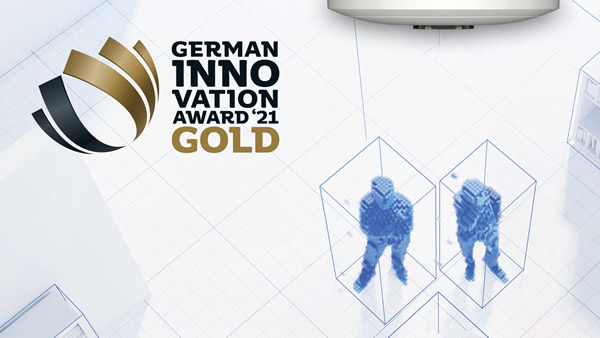Theben’s thePixa KNX optical presence detector detects how many people are in a room and where exactly they are located. This information is used to trigger predefined actions in the KNX building control system. It’s not just the building automation features that stand to gain – there’s also a great deal of added value for building operators, such as flexible options for configuring desk-sharing and optimising room occupancy and building cleaning activities.

For decades, Theben’s classic presence detectors with passive infrared technology have controlled the lighting and indoor climate of many rooms in a sustainable and energy-efficient manner. They detect people accurately and reliably based on body heat and movements. The pixel-based detection technology in thePixa KNX optical presence detectors opens up further applications with a great deal of added value and is truly innovative – as demonstrated by thePixa recently winning the German Innovation Award 2021.
GDPR-compliant detection
The detection technology used in thePixa devices is based on images with very low resolution and works in compliance with the GDPR (a feature that has been DEKRA-tested). Using image analysis, the presence detector identifies changes in the situations that arise in the rooms being monitored and processes the associated information. thePixa can then detect how many moving objects are within the detection area and count them. The result is visually processed in the form of a heat map and can be called up, together with detailed occupancy statistics in the thePixa Plug app. This information triggers a predefined action in the KNX building control system, such as starting up the ventilation system in a fully occupied meeting room. The area that is covered can be divided into different zones if required. This creates precise subdivisions in the detection area of up to 11 × 15.5 m, enabling precise lighting control in larger rooms and preventing false switching. It is also possible to set up exclusion zones in which detected movements do not trigger any actions.
Visible added value
The visualisation of detected areas by means of the heat map offers building operators a great deal of added value: for example, product presentations in department stores can be optimised to show which products customers stop at most often and therefore show the greatest interest in. Valuable information can also be obtained in office facilities: by identifying which workstations are used more or less often, it is possible to open up advantages such as efficient desk-sharing management. This allows for a flexible response to peak workloads. Operating and energy costs for buildings can be reduced. The often high installation costs that are incurred after conversion or room restructuring are completely eliminated, as new zones within the detection area can be easily created in the app.
Award-winning innovation
thePixa was recently the recipient of the German Innovation Award 2021, winning out over 680 entries. The jury’s rationale emphasised, among other things, the versatile utilisation concepts, the easy-to-use app control, the high degree of user-centricity as well as the outstanding design by the Stuttgart-based design studio ID AID, featuring clear, minimalist aesthetics. It also highlighted the added safety benefits during pandemics offered by the information on occupancy density.












